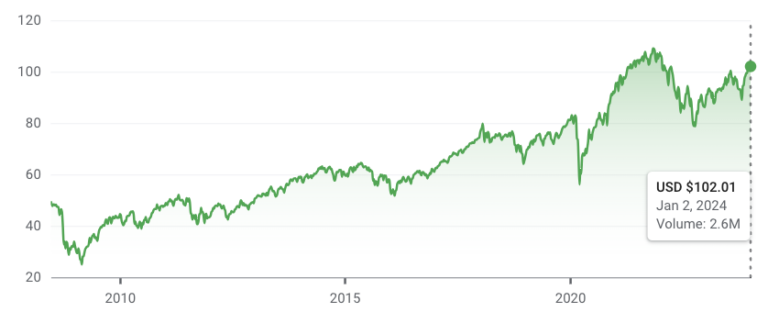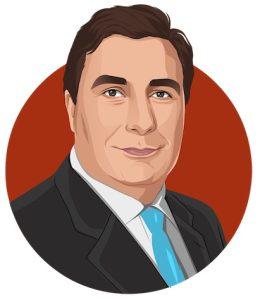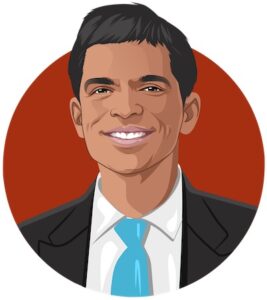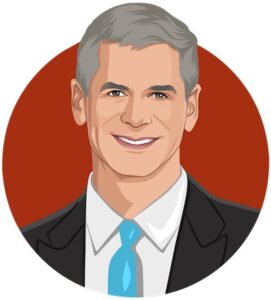Active versus passive investing
Imagine for a moment that you’re the captain of a huge hot air balloon. High above the ground, you can see the entire investment world. From here, you can see all the possible approaches and investment opportunities the earth has to offer. There are an infinite number of them, but they’re all a bit indistinct from this height.
From this perspective, there are really only two main approaches to investing on the horizon:
Passive investment. Where you “buy a slice of the stock market”, so to speak, avoiding the assessment and risks related to specific companies. In practice, by buying one or more index funds. It is this approach that I will focus on below.
Active investing. In practice, active investing is the selection of individual companies, sectors, funds, etc. with the sole aim of achieving a higher return than the market (i.e. higher than passive investing). You can choose to analyze and select companies yourself or buy the expertise through an active investment fund.

What is passive investing?
The goal of passive investing is to mimic the returns of a given slice of the market as closely as possible. No worse, no better. In practice, this is done by buying an index fund that mimics a specific market index, a so-called benchmark index, for example. S&P500 with the 500 largest companies listed in the US. For example, does Apple’s total market capitalization 6% of the US market, the index will attempt to place as close to 6% of the fund’s assets in Apple.
The easiest access to foreign index funds is through the so-called“Exchange Traded Funds“, or ETF for short. As the name suggests, these are funds that trade on the stock exchange like any other stock. This makes them easy to buy and sell at any time and doesn’t require a minimum deposit.
Why invest in passive index funds?
(or: "if you have more important goals in life than reading financial statements")
Good returns. Joel Greenblatt, a professor at Columbia Business School, writes in his book, “You can be a stock market genius”, that index funds have delivered long-term returns that are on average about 1% better than active funds. Before costs, that is. Over the past 100 years, an investment in a broad index fund would have yielded an average return in the range of 6-8% per year.
Less work. You can choose to buy just one or a few broad index funds such as a World Index or an S&P500. Here you get a very broad selection of the largest companies in the world. In principle, you don’t need to own anything else in your equity portfolio to have sufficiently diversified your risk. It’s certainly affordable.
Low costs. Today, costs are very low in the large index funds. Danish index funds are typically 0.2-0.5% per year, while the largest US ETFs are as low as 0.04%. In other words, pretty much for free. This is in contrast to active funds, where costs are often between 1.5-2.5%. It doesn’t sound like much, but it makes a very material difference in the long run.

Warren Buffett, one of the most respected active investors of the last 50 years, is himself an advocate of passive investing. He has even decided that 90% of the inheritance that goes to his widow should be invested in an S&P500 index fund when he dies. As recently as Berkshire Hathaway’s annual meeting in May 2020, Buffett reiterated his recommendation:
“In my view, for most people, the best thing to do is to own the S&P 500 index fund.”
– Warren Buffett
Eat your own cooking
But then why don’t Buffet, Greenblatt or myself just buy index funds and spend the rest of the day on the beach? Isn’t there something about eating your own baked goods?
Just because a passive strategy provides the best return for the majority of investors doesn’t mean that all investors will be best served by it. Buffett and Greenblatt have shown extraordinary competence in evaluating companies and a temperament that allows them to stand firm when others doubt. To beat the market (and an index), you have to have a different view of the companies in question than the market – and most importantly – be right.
In many ways, active investing can be compared to playing poker. From the outside looking in, all games break even. Some players walk away with a win – others with a loss. But just because the game is zero sum doesn’t necessarily mean it’s a bad idea to play. Just make sure you’re one of the better players at the table.
For me, I use a combination of passive and active investing. For example, I use index funds to gain exposure to emerging markets, such as India, where I have no special insight or access. In other industries I’ve worked in, such as finance, payments and cyber security, I have specific industry knowledge. If you have an interest in investing and specific companies, a split between passive and active can be a great approach. Whether the allocation should be 80% or 20% passive (or something else entirely) will depend on the individual investor’s interest, ability and temperament.
What should I buy?
The market for index funds and ETFs is extremely large. In fact, there are more index funds and ETFs than there are companies (yes, it’s a little bizarre). To help you keep track, I’ve created a recommended list here.




